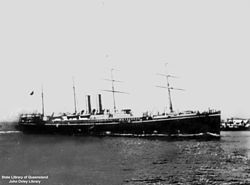Oceana (ship, 1888)
|
The identical sister ship Arcadia
|
||||||||||||||||||||||
|
||||||||||||||||||||||
|
||||||||||||||||||||||
|
||||||||||||||||||||||
|
||||||||||||||||||||||
|
||||||||||||||||||||||
The Oceana (I) was a passenger steamer put into service in 1888 by the British shipping company Peninsular and Oriental Steam Navigation Company (P&O), which was used in passenger and mail traffic from Great Britain to Australia and later India . On March 16, 1912, the ship sank in the Dover Strait after colliding with the German four-masted barque Pisagua . Nine people were killed.
The ship
The 6,610-ton steamship Oceana was at the shipyard Harland & Wolff in the Northern Irish port city of Belfast built and ran on 17 September in 1887 by the stack . The completion took place on February 26, 1888. The 142.75 meter long and 15.88 meter wide ship had four masts , two chimneys and a single propeller . She was the structurally identical sister ship of the Arcadia (I) (also 6610 BRT), which was completed shortly after her. The Oceana was powered by a three-cylinder triple expansion steam engine that developed 2000 hp and allowed a speed of 15 knots.
The ship was designed to carry 250 first class passengers and 160 second class passengers . On March 19, 1888, ran Oceana in London for their maiden voyage to Melbourne and Sydney via Colombo from (Ceylon). Her last trip on this route began on May 12, 1905. Then she was transferred to the route from London to Bombay .
Downfall
On March 15, 1912, the Oceana put under the command of Captain Thomas H. Hyde in Tilbury for another crossing to Bombay. On board were 210 crew members, 40 passengers and gold and silver bars valued at 747,110 pounds sterling . The day after departure, the Oceana was steaming through calm seas at almost full speed. The Pisagua , a 2,850 GRT four-masted barque belonging to the German shipping company F. Laeisz , was approaching in the opposite direction and was on the way from Mejillones to Hamburg . The Pisagua was sailing under full sail at a speed of almost 20 knots.
The two ships were about half a mile apart when they sighted each other. The master of the Pisagua gave a beacon which was recognized by the officer in charge on board the Oceana . He then gave the order to turn the rudder to port . The pilot , who was still on board at the time, came out of the house of cards onto the bridge and realized that this maneuver would not be sufficient. He shouted "Hard Port", but before the Oceana could get out of the Pisagua's course , her bow dug into the port side of the steamship and left a large hole there. The collision occurred four nautical miles from Beachy Head .
The Pisagua was drifting away with her bow pushed in and the foremast collapsed. On board the Oceana the watertight bulkheads were closed and Captain Hyde ordered the lifeboats to be made ready . Since the Oceana was still going during the sinking , one of the boats capsized and seven passengers and two crew members drowned. Most of the people were taken on board the Sussex canal ferry that had received the Oceana distress call .
The Oceana was from the tractor alert from Newhaven taken in tow, but developed a flip side and fell forward with the bow to 22 clock. She sank in shallow waters near the seaside resort of Eastbourne , so that her masts protruded from the water after sinking. Within the next 10 days, salvage divers were able to recover most of the bars from the wreck . In July 1912 the wreck was blown up because it posed a threat to shipping.
Web links
- Brief description in The Ships List (above)
- Brief description of the collision and the sinking
- The wreck of the Oceana as a diving destination. Archived from the original on October 20, 2013 ; Retrieved April 4, 2016 .
- Entry in the wreck database

